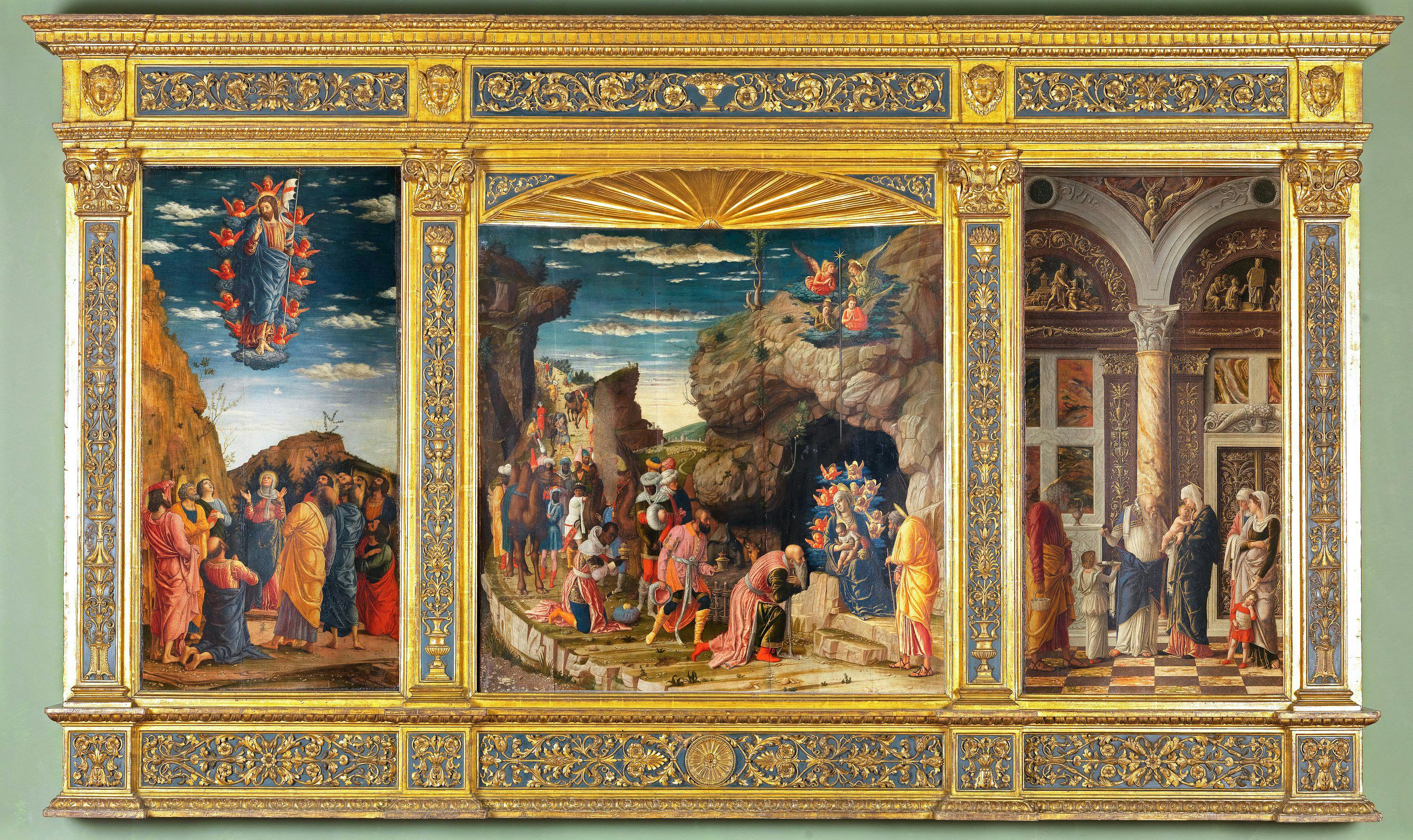Ascension of Christ; Adoration of the Magi; Presentation of Christ at the Temple
Andrea Mantegna (Isola di Carturo (PD) 1431 - Mantua 1506)
Today the three panels form part of a triptych inserted in a Renaissance-style frame dating back to the 19th century. This is therefore an arbitrary reconstruction, and the original context must have been very different. The three scenes depict three Gospel stories. The one in the center illustrates, with many figures and details, the homage of the Magi to Baby Jesus, who sits on the lap of the Virgin Mary in the glory of angels and under the watchful gaze of the elderly Joseph. The natural scenery in which the episode is set is replaced in the scene on the right by a sumptuous and majestic architecture: the temple where Mary, according to Jewish custom, went to purify herself forty days after giving birth and where Jesus received the circumcision. The scene depicts Jesus in his mother's arms, retreating in fear before the priest who is about to perform the rite. On the other hand, the scene on the left is part of the stories of post-mortem Christ, and describes the last episode narrated in the Gospel of Luke, namely the ascension to heaven of the risen Christ, in the presence of his mother Mary and the apostles.
The three panels were part of a decorative cycle created by Andrea Mantegna and commissioned by Ludovico Gonzaga (1412-1478) for the chapel of the Saint George Castle in Mantua, which was lost due to subsequent renovations of the building. To the same cycle also belonged the scene of the Death of the Virgin, which is currently divided between Madrid (Prado Museum, inv. no. 248) and Ferrara (National Art Gallery inv. no. 333) and, perhaps, the Resurrection of Christ and Descent into Limbo, divided between Bergamo, Accademia Carrara, and a private collection. However, the reconstruction of the pictorial cycle, as well as its original location and the time of its execution, are still largely debated. The concave shape of the panel with the Adoration of the Magi, which is also wider than the other panels (while originally it must have been of the same height), suggests that the painting was made to fit a curved wall, probably a niche or a small apse in the chapel.
The creation of the pictorial cycle in the chapel of the Saint George Castle coincides with the period in which Andrea Mantegna moved from Padua to Mantua, where he was documented as early as 1460 and where he stayed until his death, thus becoming the favourite painter of the reigning family, the Gonzaga.
The three panels now in the Uffizi became famous in Florence in the collection of Don Antonio de' Medici (1576-1621), which he had inherited from his parents, Grand Duke Francesco I and Bianca Cappello, both died in 1587. It is believed that Francesco received the paintings on the occasion of the wedding of his daughter Eleonora with Vincenzo I Gonzaga in 1584.
Among the greatest interpreters and promoters of the renewal of north Italian painting following a Renaissance style, Andrea Mantegna was skilled in the use of perspective, as it is also revealed by how the sense of depth is given through the chequered floor in the scene of the Presentation at the Temple. The painter showed a keen interest in the culture and art of the ancient Greco-Roman civilization, on which he concentrated almost with the spirit of an archaeologist. He was an extraordinary draughtsman and managed to translate into painting Donatello's sculpture (1386-1466), who was active for a long time in Padua, Mantegna's birthplace.
R. Lightbown, Mantegna, with a complete catalogue of paintings, drawings and prints, Oxford 1986, pp. 411-415;L. Attardi, in Mantegna 1431-1506, a cura di G. Agosti e D. Thiébaut, Parigi – Milano 2008, pp. pp. 192-193; G. Valagussa, in Andrea Mantegna. Rivivere l'antico, costruire il moderno, Torino, 2019, p. 236
